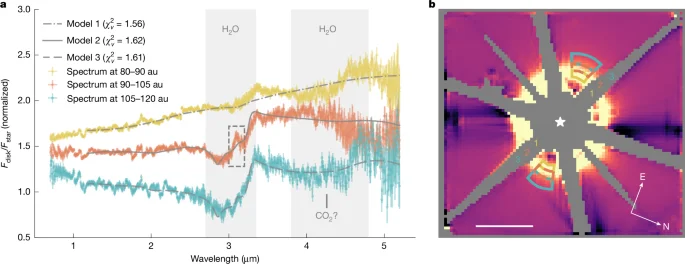
Webb Telescope Uncovers Frozen Water in Young Star System: A Key to Planet Formation
In a groundbreaking discovery, NASA's James Webb Space Telescope has definitively detected frozen water around a young, sun-like star called HD 181327. This marks the first unambiguous detection of crystalline water ice in a debris disk beyond our solar system, offering invaluable insights into the early stages of planetary system development.
The finding, published in Nature, highlights the presence of crystalline water ice alongside fine dust particles. These icy grains are similar to those found in Saturn's rings and the Kuiper Belt, suggesting similar physical processes are at play in shaping debris disks both near and far.
"Webb unambiguously detected not just water ice, but crystalline water ice, which is also found in locations like Saturn’s rings and icy bodies in our solar system’s Kuiper Belt," emphasized Chen Xie from Johns Hopkins University, the study's lead author. This discovery strengthens the idea that planet formation mechanisms are universal across the galaxy.
HD 181327, estimated to be around 23 million years old, is a dynamic system with ongoing collisions within its debris disk. These collisions release fine dust and crystalline water ice particles, detected by Webb's highly sensitive instruments. The debris disk mirrors our own solar system's Kuiper Belt, providing a snapshot of the dynamic processes contributing to planetary assembly.
The distribution of water ice isn't uniform across the disk. Webb's observations show a high concentration of ice in the outer regions, where it's cold enough to remain frozen. "The outer area of the debris disk consists of over 20% water ice," Xie noted. Moving inward, the abundance of ice decreases, likely due to the star's ultraviolet radiation vaporizing the ice in the warmer regions. Some water might also be trapped inside larger planetesimals, which are harder for Webb to detect.
Water ice plays a crucial role in planet formation, influencing the growth of giant planets and possibly delivering water to rocky worlds. The detection of crystalline water ice in HD 181327's debris disk suggests that water could be common in young planetary systems, potentially making habitable environments more widespread.
"The presence of water ice helps facilitate planet formation. Icy materials may also ultimately be 'delivered' to terrestrial planets that may form over a couple hundred million years in systems like this," explained Xie.
This exciting discovery opens new avenues for researchers to study how water is distributed and transported in these disks, unraveling the history of planet formation and the potential for life beyond our solar system. The James Webb Space Telescope continues to revolutionize our understanding of the universe.
What implications do you think this discovery has for the search for habitable planets? Share your thoughts in the comments below!